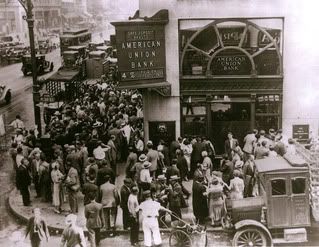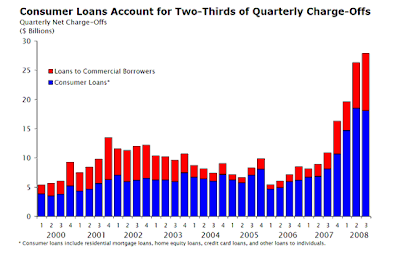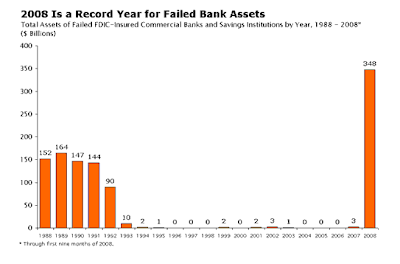Here’s Mish’s summary of the FDIC Quarterly Banking Profile, along with helpful colorful charts and his prediction for the market from now and into 2009. 
Grim FDIC Quarterly Banking Profile
Courtesy of Mish, at Global Economic Trend Analysis
Inquiring minds are looking at the FDIC Quarterly Banking Profile for the third quarter of 2008. Here are some highlights from the report:
- Asset-Quality Problems Continue to Depress Earnings
- Net Income of $1.7 Billion is Second-Lowest Since 1990
- Loan-Loss Rate Rises to 17-Year High
- Net Interest Margins Register Improvement
- Failures Are Highest Quarterly Total in 15 Years
Return On Assets .05 Percent
Expenses for credit losses topped $50 billion for a second consecutive quarter, absorbing one-third of the industry’s net operating revenue (net interest income plus total noninterest income). Third quarter net income totaled $1.7 billion, a decline of $27.0 billion (94.0 percent) from the third quarter of 2007. The industry’s quarterly return on assets (ROA) fell to 0.05 percent, compared to 0.92 percent a year earlier. This is the second-lowest quarterly ROA reported by the industry in the past 18 years.
Nine Failures in Third Quarter Include Washington Mutual Bank
The number of insured commercial banks and savings institutions fell to 8,384 in the third quarter, down from 8,451 at midyear. During the quarter, 73 institutions were absorbed in mergers, and 9 institutions failed. This is the largest number of failures in a quarter since the third quarter of 1993, when 16 insured institutions failed. Among the failures was Washington Mutual Bank, an insured savings institution with $307 billion in assets and the largest insured institution to fail in the FDIC’s 75-year history. There were 21 new institutions chartered in the third quarter, the smallest number of new charters in a quarter since 17 new charters were added in the first quarter of 2002. Four insured savings institutions, with combined assets of $1.0 billion, converted from mutual ownership to stock ownership in the third quarter. The number of insured institutions on the FDIC’s "Problem List" increased from 117 to 171, and the assets of "problem" institutions rose from $78.3 billion to $115.6 billion during the quarter. This is the first time since the middle of 1994 that assets of "problem" institutions have exceeded $100 billion.
Deposit Insurance Fund (DIF) Underfunded
The Deposit Insurance Fund (DIF) decreased by 23.5 percent ($10.6 billion) during the third quarter to $34,588 million (unaudited). Accrued assessment income increased the fund by $881 million. Interest earned, combined with realized and unrealized gains (losses) on securities, added $653 million to the insurance fund. Operating and other expenses, net of other revenue, reduced the fund by $233 million. The reduction in the DIF was primarily due to an $11.9 billion increase in loss provisions for bank failures.
The DIF’s reserve ratio equaled 0.76 percent on September 30, 2008, down from 1.01 percent at June 30, 2008 and 1.22 percent one year ago. The September figure is the lowest reserve ratio for the combined bank and thrift insurance fund since June 30, 1994, when the reserve ratio was 0.74 percent.
DIF Restoration Plan
Recent bank failures significantly increased the Deposit Insurance Fund’s losses, resulting in a decline in the reserve ratio. As of September 30, 2008, the reserve ratio stood at 0.76 percent, down from 1.01 percent at June 30 and 1.19 percent at March 31. The Federal Deposit Insurance Reform Act of 2005 (the Reform Act) requires that the FDIC’s Board of Directors adopt a restoration plan when the Deposit Insurance Fund reserve ratio falls below 1.15 percent or is expected to within 6 months.
Absent extraordinary circumstances, the restoration plan must provide that the reserve ratio increase to at least 1.15 percent no later than five years after the plan’s establishment. The FDIC Board adopted a restoration plan on October 7.
24% of Institutions Reported a Net Loss
Almost one in every four institutions (24.1 percent) reported a net loss for the quarter, the highest percentage in any quarter since the fourth quarter of 1990, and the highest percentage in a third quarter in the 24 years that all insured institutions have reported quarterly earnings.
Charts Tell The Story
Click on any chart for a sharper image
All of the above text and charts with the exception of a few bold headlines is from the report.
The trend is clear and that trend is a rapid deterioration of asset values, earnings, and income. Looking ahead, chargeoffs are going to soar from already high levels in response to rapidly rising unemployment.
The financial sector bottom is not in. And until the financial sector bottom is in, it is unlikely that the overall market bottom is in. Look for fresh lows in 2009 after a technical rally that may last for the remainder of the year.








